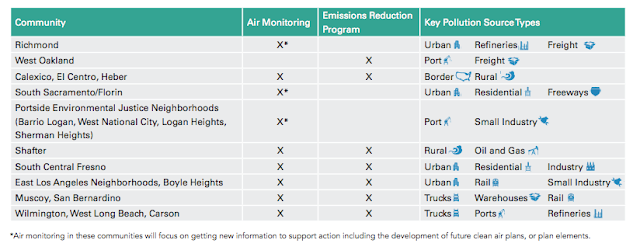CARB adopts blueprint for statewide community air protection in areas most impacted by pollution
CARB
adopts blueprint for statewide community air protection in areas most impacted
by pollution
Board also selects first 10 communities
for additional focused actions under AB 617
SACRAMENTO – Opening a new chapter in California’s
fight against air pollution, the California Air Resources Board took key
steps toward implementing the Community Air
Protection Program, a first-of-its-kind effort to improve air quality in local communities that face the worst impacts of air pollution.
“This program
represents a completely new approach to improving air quality in California’s
most impacted communities. The State, working together with local pollution
control agencies and community-based organizations, will focus monitoring,
enforcement and regulatory activities on the sources of greatest concern to
residents.” said Chair Mary D. Nichols.
At its September monthly
meeting, the Board adopted a blueprint
for the program describing how CARB will work with local residents, air districts and other
partners to identify local air quality problems, develop solutions and track
progress together. The new approach to improving air quality in heavily
impacted communities was established by Assembly Bill 617, signed
by Governor Brown in July 2017.
The Board also selected
the first 10 communities that will be the focus of additional targeted actions.
Located across the state and varying in size and population, these communities
have among the highest cumulative impacts from multiple air pollution sources
in California. More communities will be added to the program in the future.
“Today’s vote
starts to repair the harm to communities like mine who are affected by
emissions from railyards, trucks and more pollution sources,” said CARB Board
Member Senator Ricardo Lara.” CARB is delivering on the promise the Legislature
made by passing AB 617 to help those most affected by pollution so they no
longer have to accept dirty air as the cost of jobs and opportunity.”
Blueprint for Community Air
Protection
The Board’s
action follows a 10-month public process that included community tours,
meetings with residents, and workshops around the state, in addition to feedback
received from hundreds of communities. The first draft blueprint was released
in February, and the final proposal was released on August 24.
“The blueprint
sets in motion our plan to uplift California’s underserved, pollution burdened
communities,” said CARB Board Member Assemblymember Eduardo Garcia, AB 617
joint author. “It is a great first step in establishing the foundation for AB
617 implementation in a diverse selection of regions, including Imperial
County, a rural area in my district uniquely challenged by cross-border
pollution, the Salton Sea and severe socioeconomic disparities. We look forward
to being able to steer these investments towards community-led emission
reduction and air monitoring programs.”
The blueprint
describes:
- Steps CARB will take to work with communities and air districts to improve air quality in impacted communities statewide
- Process for selecting communities for targeted clean air improvements
- Procedures for air districts and communities to set up air pollution monitoring
- Better data on pollution sources and making data more accessible
- Required elements to be included in community emission-reduction programs
- Incentive investments to help purchase cleaner vehicles and equipment
- Metrics to track and report progress in reducing emissions
Together, these
actions are designed to deliver cleaner air to communities, provide
accountability and transparency, and promote a collaborative process.
Focused Action in 10
Initial Communities
The 10
communities selected by the Board for focused action face disproportionate
impacts from multiple sources of air pollution, including freight facilities,
ports, large and small industrial facilities, freeways, oil and gas facilities,
and busy border crossings. Residents of these communities also experience high
levels of poverty and unemployment.
Under the Community
Air Protection Program, these communities will be targeted for focused actions
to improve air quality. These include setting up community air pollution
monitoring systems, developing community clean air programs focused on cutting
emissions from local pollution sources, or both.
GARCIA QUOTE
Following
the blueprint adoption, regional air districts will develop community emissions
reduction programs in collaboration with local community steering
committees. These programs must include new strategies to
address air pollution from stationary, mobile and area-wide sources that
contribute to the burden on impacted communities.
Strategies
required to be considered under the blueprint include new regulatory and
enforcement actions, facility risk-reduction audits, enhanced air quality
permitting requirements, incentive programs, and land use and transportation
planning.
The first
cohort will serve as a model for future efforts in other areas in coming years.
Related Community Action Efforts
The September Board meeting actions
are part of the state’s ongoing commitment to address the disproportionate
impacts of air pollution on disadvantaged communities. Other recent actions
include the following:
- In June, CARB awarded $10 million in grants to help 25 community-groups and three Native American Tribes reduce air pollution in their neighborhoods in support of AB 617 implementation.
- Earlier this month, CARB also selected four Los Angeles and Kern County communities for an in-depth study of air quality impacts near oil and gas facilities.
- CARB announced more than $200 million in new state funding for clean freight transportation. This is in addition to the $1.2 billion the state has already pumped into projects that put a growing number of zero-emission and low-carbon buses, trucks and cars onto California's roads and highways as of May.
To view an
interactive map of these efforts including Supplemental Environmental Projects,
existing community monitoring and more, click
here.
For more
information about the Community Air Protection Program, click
here.

